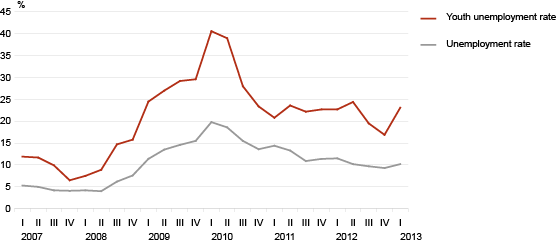In the 1st quarter youth unemployment increased
According to the data of the Labour Force Survey, the unemployment rate was higher than in the previous quarter, when it was 9.3%, but lower than in the same quarter of the previous year (11.5%). The estimated number of unemployed persons was 71,000, which was by 7,000 persons more compared to the previous quarter. The unemployment increased among men as well as among women.
The number of the unemployed was primarily affected by the increased economic activity of the population and not by the decreased employment. The number of economically inactive persons (not working nor looking for job) decreased.
By age groups, the unemployment was the smallest among elderly people (aged 50–74) (6.9%) and their participation on the labour market increased compared to the previous quarter. The unemployment rate of persons aged 25–49 was 9.9% and it increased slightly compared to the previous quarter. The unemployment of persons aged 15–24 exceeded the unemployment of elderly people by several times. More than half of the 7,000 unemployed persons who were added compared to the previous quarter were under 25 years of age.
Although the majority of people aged 15–24 (61%) are economically inactive (mainly due to studies), unemployment has always been bigger among the youth than among older people. Some of the reasons are lower qualifications and less job experience of people under 25. The youth unemployment rate or the share of unemployed persons aged 15–24 among the labour force of the same age was 23.1%, which is bigger compared to the previous quarter as well as to the same quarter of the previous year (then the youth unemployment rate was 16.9% and 22.7%, respectively). Among persons aged less than 25, the estimated number of employed persons was 51,000 and the number of unemployed persons – 16,000.
The number of the unemployed grew primarily due to the growth of short-term unemployment. The number of long-term unemployed (i.e. people who had been looking for a job for one year or more) remained unchanged (33,000). The long-term unemployment rate was 4.7% in the 1st quarter.
In the 1st quarter, the employment rate of the population aged 15–74 was 60.8%. It decreased slightly (by 0.2 percentage points) compared to the previous quarter. The estimated number of employed persons was 623,000 and it remained on the same level compared to the previous quarter.
The employment of females slightly increased as the employment of males decreased. There was a remarkable decline in the number of persons employed in construction, working both in Estonia and abroad.
The share of economically inactive persons (students, retired persons, homemakers, discouraged persons, etc.) in the population aged 15–74 decreased. It was 32% in the 1st quarter, i.e. 330,000 persons, which are 5,000 persons less than in the previous quarter. Among inactive persons, the number of persons inactive due to health problems decreased the most.
In the calculation of the estimates for 2012 and 2013, the estimated number of population published by Statistics Estonia as of 1 January 2012 has been used to ensure the comparability in time series; this population figure has not been adjusted with the data of the 2011 Population and Housing Census. The Labour Force Survey data for 2000–2013 will be adjusted after the revision of the population number during the years between the two censuses and will be published in the 1st quarter of 2014.
Unemployment rate is the share of the unemployed in the labour force (the sum of the employed and unemployed persons). Long-term unemployment rate is the share of people who have been unemployed for a year or longer among the total labour force. Employment rate is the share of the employed in the working-age population (aged 15–74). The estimates are based on the data of the Labour Force Survey. Statistics Estonia has been conducting the Labour Force Survey since 1995 and every quarter 5,000 persons participate in the survey. The Labour Force Survey is carried out by statistical organisations in all the European Union Member States on the basis of a harmonised methodology.
Unemployment rate and youth unemployment rate, 1st quarter 2007 – 1st quarter 2013
